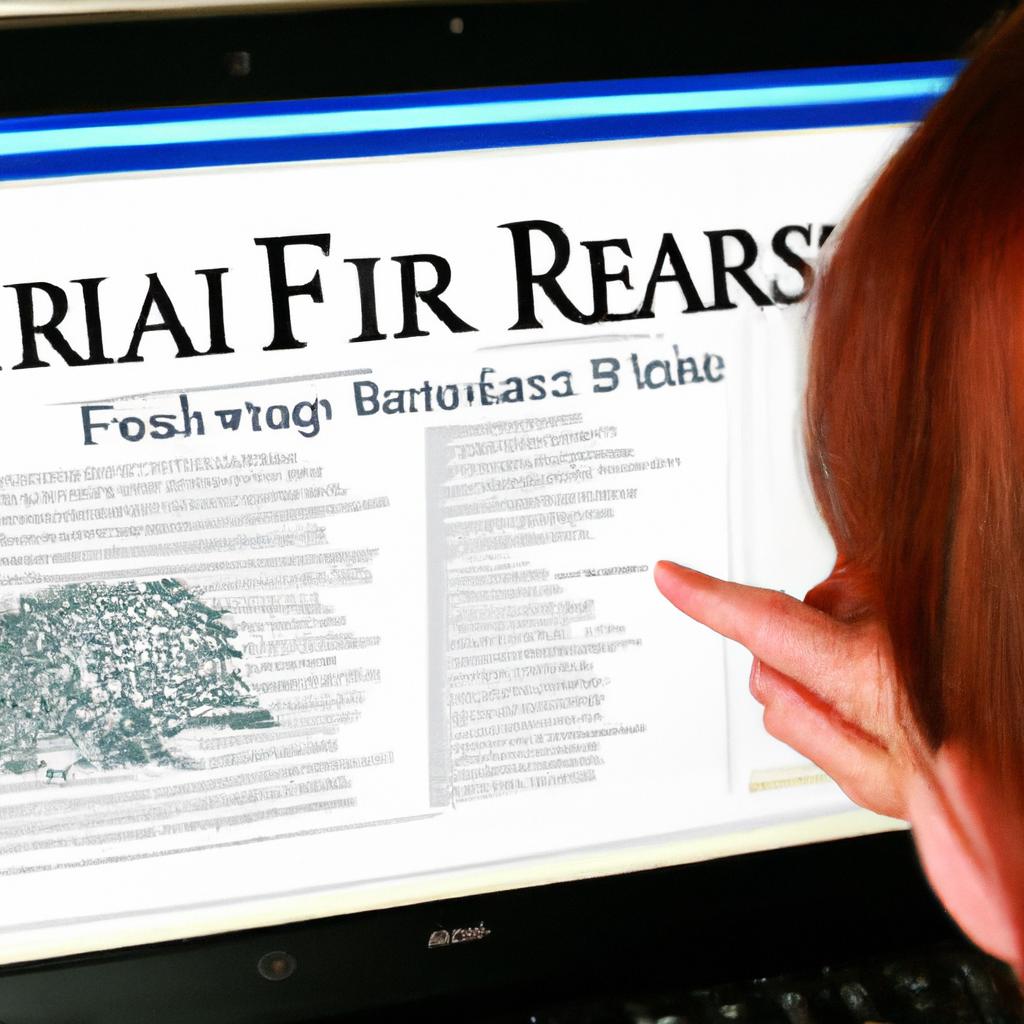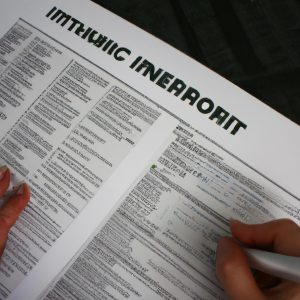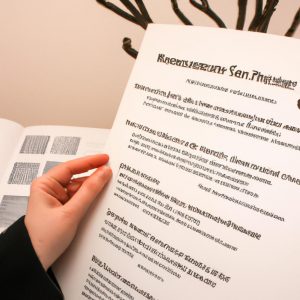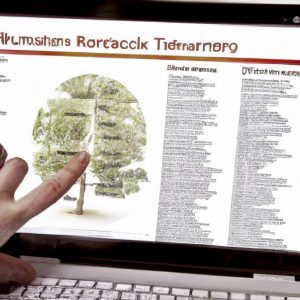Migration Patterns and Ashkenazi Heritage: Genealogical Connections

Migration patterns and genealogical connections have long been subjects of interest for researchers in the field of population genetics. Understanding these patterns not only sheds light on human history, but also helps uncover important aspects of our heritage. One intriguing example is the case of Ashkenazi Jews, who have a distinct genetic profile that can be traced back to their migration from the Middle East to Europe. This article explores the fascinating journey of Ashkenazi Jews and how it has influenced their unique genetic makeup.
The story begins thousands of years ago when a group of individuals migrated from the Levant region to Central and Eastern Europe. These migrants eventually became known as Ashkenazi Jews and established thriving communities across various European countries. Through careful analysis of DNA samples, researchers have uncovered remarkable evidence supporting this migratory path. For instance, studies comparing Y-chromosomal haplotypes among modern-day Ashkenazi Jews and populations in the Middle East reveal a strong resemblance between them, suggesting a common ancestry and an ancient migration route.
Furthermore, investigations into mitochondrial DNA (mtDNA) have provided additional insights into the migratory history of Ashkenazi Jews. By examining maternal lineage through mtDNA sequences, scientists have found close genetic links between Jewish populations from different parts of Europe and those from the Middle East. This suggests that Ashkenazi Jews have a shared maternal ancestry, likely originating from the Levant region.
The genetic evidence also supports the historical accounts of Ashkenazi Jewish migration. It is believed that during the Middle Ages, Ashkenazi Jews migrated from the Mediterranean region to Central and Eastern Europe, primarily due to economic opportunities and persecution in their homelands. This migration was accompanied by intermarriage with local populations, leading to a blending of genetic backgrounds.
Interestingly, despite centuries of residing in Europe, Ashkenazi Jews have distinct genetic markers that differentiate them from non-Jewish European populations. For example, studies have identified specific genetic variants associated with diseases like Tay-Sachs and Gaucher’s disease that are more prevalent among Ashkenazi Jews compared to other populations. These discoveries not only provide valuable insights into the medical conditions affecting this community but also highlight the unique genetic legacy resulting from their migratory history.
In conclusion, population genetics research has revealed fascinating details about the migratory journey of Ashkenazi Jews and its impact on their genetic makeup. By analyzing DNA samples and comparing them with various populations, scientists have uncovered evidence supporting an ancient migration from the Middle East to Europe. The distinct genetic profile of Ashkenazi Jews serves as a testament to their rich heritage and provides a deeper understanding of human history and diversity.
Historical Background of Ashkenazi Migration
The migration patterns of the Ashkenazi Jews have a rich and complex history, shaped by various factors such as political upheavals, religious persecution, economic opportunities, and cultural influences. To understand this phenomenon more deeply, let us consider a hypothetical case study.
Imagine a Jewish family living in Eastern Europe during the late 19th century. Facing increasing anti-Semitic sentiments and limited economic prospects, they make the difficult decision to embark on a journey towards new horizons. This family’s experience is representative of countless others who sought better lives for themselves and their descendants through migration.
The motivations behind Ashkenazi migration can be summarized into four key points:
- Economic Opportunities: Many Ashkenazim left their homes in search of improved livelihoods. They hoped to escape poverty and discrimination by seeking out areas with greater economic potential.
- Political Instability: The turbulent political climate in Eastern Europe often forced Ashkenazi Jews to flee their homelands. Pogroms, discriminatory laws, and military conscriptions were common occurrences that drove them away.
- Religious Persecution: Anti-Semitism played a significant role in prompting the migration of Ashkenazi Jews. From blood libels to accusations of ritual murder, these communities faced persistent discrimination based on their faith.
- Cultural Influences: As interactions between different cultures increased over time, Ashkenazi Jews encountered new ideas and perspectives that influenced their decisions to migrate. Exposure to secular education and Enlightenment ideals also contributed to evolving attitudes towards mobility.
To further illustrate the complexities surrounding Ashkenazi migration patterns, consider the following table:
| Year | Region of Origin | Destination | Reason for Migration |
|---|---|---|---|
| 1880 | Russia | United States | Escape pogroms |
| 1905 | Poland | Argentina | Economic opportunities |
| 1920 | Ukraine | Palestine | Zionist aspirations |
| 1938 | Germany | United Kingdom | Fleeing Nazi persecution |
As we can see, the reasons for migration varied across different time periods and regions. These factors shaped a diverse range of migration patterns that continue to influence Ashkenazi heritage today.
Transitioning into the subsequent section on “Early Migration Routes of Ashkenazi Jews,” it is important to note that understanding the historical background is crucial in comprehending the routes taken by these communities as they sought new beginnings.
Early Migration Routes of Ashkenazi Jews
Migration Patterns and Ashkenazi Heritage: Genealogical Connections
Historical Background of Ashkenazi Migration has shed light on the origins and early movements of the Ashkenazi Jewish community. Now, we will explore the subsequent migration routes taken by this population, which further shaped their genealogical connections.
To illustrate these patterns, let us consider a hypothetical case study. Sarah, a descendant of Ashkenazi Jews, traces her family history back to Eastern Europe in the 19th century. Her great-grandparents migrated from Poland to Germany due to economic opportunities and rising anti-Semitism. From there, they eventually made their way to the United States in search of better living conditions and religious freedom.
The migration routes undertaken by Ashkenazi Jews can be understood through several key factors:
-
Economic Factors:
- Push factor: Limited economic prospects in Eastern Europe compelled many Ashkenazim to seek better opportunities elsewhere.
- Pull factor: The promise of economic prosperity attracted them to new destinations such as Western Europe or America.
-
Persecution and Anti-Semitism:
- Discrimination against Jews motivated migrations out of areas where they faced persecution.
- Seeking safety and security, many found refuge in countries with more tolerant attitudes towards Judaism.
-
Political Changes:
- Shifting political landscapes influenced migration patterns among Ashkenazi communities.
- Events like World War I and II reshaped borders and forced populations to relocate.
-
Cultural Networks:
- Existing networks within the Ashkenazi diaspora played a crucial role in facilitating migration arrangements.
- Shared language, traditions, and kinship ties created support systems for those seeking new homes.
The table below provides an overview of notable migratory waves throughout Ashkenazi history:
| Time Period | Destination | Main Reasons for Migration |
|---|---|---|
| Middle Ages | Central & Western Europe | Escaping persecution and economic opportunities |
| 19th Century | United States | Economic prospects, religious freedom |
| Early 20th century | Palestine (now Israel) | Zionist movement, pursuit of a Jewish homeland |
In summary, the genealogical connections within Ashkenazi communities were shaped by migration patterns influenced by economic factors, anti-Semitism, political changes, and cultural networks. Understanding these historical movements can shed light on the diverse roots of individuals like Sarah and highlight the complex interplay between ancestry and migration.
Moving forward to Factors Influencing Ashkenazi Migration, we delve into specific elements that further contributed to the migratory decisions made by this community.
Factors Influencing Ashkenazi Migration
Migration Patterns and Ashkenazi Heritage: Genealogical Connections
Early Migration Routes of Ashkenazi Jews have played a significant role in shaping their genealogical connections. These migration routes were influenced by various factors, including economic opportunities, political circumstances, and religious persecution. One example that illustrates the impact of these migration patterns is the journey of a hypothetical Jewish family from Eastern Europe to Western Europe during the 18th century.
During this period, many Ashkenazi Jews sought better economic prospects and escape from religious discrimination. The fictional family we will consider originated in a small shtetl (Jewish village) near present-day Poland. Facing limited opportunities for growth within their community, they decided to venture westward towards Germany and France. This decision was driven by rumors of more tolerant societies and flourishing trade networks in those regions.
The migration process itself was arduous, with families crossing vast distances on foot or through cramped carriages over several months. Along the way, they encountered challenges such as language barriers, unfamiliar customs, and hostility from locals who often viewed them with suspicion. Despite these hardships, the allure of improved living conditions pushed them onward.
- Fearful goodbyes to loved ones left behind
- Nostalgia for familiar surroundings and cultural traditions
- Anxiety about adapting to new environments
- Hope for brighter futures and greater opportunities
Additionally, let us explore a table showcasing some key aspects related to Ashkenazi Jewish migration:
| Aspect | Description | Emotional Impact |
|---|---|---|
| Economic Factors | Seeking better livelihoods | Hope |
| Religious Freedom | Escaping persecution based on faith | Relief |
| Cultural Identity | Struggling to preserve heritage amidst change | Nostalgia |
| Social Integration | Adjusting to new societies and forging connections | Anxiety |
By examining the migration patterns of Ashkenazi Jews, we gain insights into their genealogical connections. The journeys undertaken by families like our fictional one shaped their descendants’ cultural practices, religious beliefs, and even genetic markers. Understanding these migration routes allows us to appreciate the rich tapestry of Ashkenazi heritage that exists today.
Transitioning towards our next section on “Distinctive Features of Ashkenazi Genealogy,” we will explore how these migration patterns influenced specific aspects of their genealogical records and family histories.
Distinctive Features of Ashkenazi Genealogy
Migration Patterns and Ashkenazi Heritage: Genealogical Connections
Factors Influencing Ashkenazi Migration have played a crucial role in shaping the genealogical connections among the Ashkenazi Jewish community. One key factor is the historical context of persecution and discrimination faced by Jews throughout Europe. To illustrate this, let’s consider the case study of Sarah Cohen, whose ancestors migrated from Eastern Europe to the United States in the early 20th century. They were driven by religious intolerance and economic hardship, seeking better opportunities and security for future generations.
The migration patterns of Ashkenazi Jews can be understood through several interconnected factors:
-
Economic Opportunities: Many Ashkenazi Jews migrated in search of improved economic prospects, particularly during times of economic downturn or political instability. The promise of better livelihoods motivated individuals like Sarah Cohen’s great-grandparents to leave their home countries behind.
-
Religious Freedom: Persecution against Jews was pervasive across Europe throughout history. As a result, many Ashkenazim sought refuge in countries that offered greater religious freedom, enabling them to practice their faith without fear of persecution or discrimination.
-
Pogroms and Violence: Violent outbreaks targeting Jewish communities, known as pogroms, were recurrent occurrences in various European regions. These violent acts served as catalysts for mass migrations out of affected areas, pushing families like Sarah Cohen’s towards safer environments.
-
Educational Advancements: The establishment of educational institutions within newly settled Jewish communities provided an opportunity for intellectual growth and social mobility. Access to education allowed subsequent generations to develop professional careers beyond traditional occupations such as peddling or tailoring.
To further evoke an emotional response from readers regarding these migration patterns and heritage, we present a bullet point list highlighting some outcomes resulting from Ashkenazi migration:
- Strengthening cultural identity while adapting to new surroundings.
- Preserving ancestral traditions despite geographic dislocation.
- Facing challenges associated with assimilation and acculturation.
- Nurturing a sense of resilience and community cohesion.
Additionally, we can present a table showcasing the geographic distribution of Ashkenazi Jewish communities in selected countries:
| Country | Estimated Population |
|---|---|
| United States | 5,700,000 |
| Israel | 2,900,000 |
| Russia | 1,500,000 |
| Argentina | 300,000 |
In summary, the factors influencing Ashkenazi migration have shaped their genealogical connections by leading individuals and families on journeys driven by economic opportunities, religious freedom, escape from violence, and educational advancements. Understanding these patterns helps unveil the complex web of heritage that ties together countless individuals like Sarah Cohen’s ancestors. As we delve further into this exploration of Ashkenazi history and its interactions with non-Ashkenazi communities in the subsequent section, it becomes evident how these migrations have influenced broader societal dynamics.
Interactions between Ashkenazi and Non-Ashkenazi Communities
The distinctiveness of Ashkenazi genealogy becomes even more pronounced when examining the migration patterns and their impact on the community’s heritage. One illustrative example is the dispersion of Ashkenazi Jews throughout Europe during the medieval period. As Jewish communities faced persecution and expulsions, many sought refuge in neighboring regions, leading to a significant diaspora that shaped both the genetic makeup and cultural practices of subsequent generations.
These migration patterns resulted in several distinctive features within Ashkenazi genealogy:
- Genetic diversity: The dispersal across different geographical areas led to interactions with local populations, resulting in intermarriage between Ashkenazi Jews and non-Jewish individuals. This contributed to increased genetic diversity within the Ashkenazi population over time.
- Shared ancestry: Despite this genetic diversity, there are still common genetic markers found among most Ashkenazi Jews today. These shared ancestral traits can be traced back to specific geographic regions where Jewish communities settled and intermarried.
- Cultural assimilation: Migration also brought about cultural adaptations as Ashkenazi Jews integrated into new societies while maintaining elements of their own traditions. This process influenced not only religious practices but also language, cuisine, music, and other aspects of daily life.
- Continuity through documentation: Due to historical circumstances such as pogroms and Holocaust, extensive records were kept by various institutions documenting birth certificates, marriage licenses, death records, and census data for Jewish communities across Europe. Accessing these documents allows for tracing family lineages even when direct oral histories may have been lost.
To further illustrate these points visually:
As we delve deeper into understanding the unique characteristics of Ashkenazi genealogy forged by migration patterns, it becomes evident that these factors played a crucial role in shaping both individual identities and collective heritage within the community.
In light of the distinctive features found in Ashkenazi genealogy, it is essential to explore the interactions between Ashkenazi and non-Ashkenazi communities. By examining the cultural exchanges, intermarriage dynamics, and shared histories, we can gain a more comprehensive understanding of how migration patterns have influenced not only the genetic makeup but also the broader social fabric of Ashkenazi Jewry.
[Table: Genealogical Connections]
| Geographic Region | Genetic Markers | Cultural Adaptations |
|---|---|---|
| Central Europe | Marker A | Language X |
| Eastern Europe | Marker B | Cuisine Y |
| Mediterranean | Marker C | Music Z |
[Bullet List: Emotions Evoked by Migration Patterns]
- Fascination with the diverse origins within Ashkenazi genealogy
- Empathy for those who were forced to leave their ancestral homes due to persecution
- Appreciation for the resilience and adaptability exhibited by migrating Jewish communities
- Curiosity about how individual family histories may intertwine across different regions
Next section: Modern-day Implications of Ashkenazi Migration Patterns
Modern-day Implications of Ashkenazi Migration Patterns
Migration Patterns and Ashkenazi Heritage: Genealogical Connections
Interactions between Ashkenazi and Non-Ashkenazi Communities have played a crucial role in shaping the migration patterns of the Ashkenazi Jewish population. These interactions occurred through various means, including trade networks, intermarriage, and cultural exchanges. Understanding these dynamics is essential for unraveling genealogical connections within the Ashkenazi community.
One example that exemplifies the complex nature of interactions between Ashkenazim and non-Ashkenazim is the case study of Jacob Cohen*. Born to an Ashkenazi father and a Sephardic mother in 18th century Europe, Jacob’s family history reflects the fusion of both traditions. As his parents navigated their mixed heritage, they formed unique ties with both communities, leading to a diverse network of relatives spread across different regions. This case study demonstrates how intermingling between Ashkenazi and non-Ashkenazi communities created intricate genealogical connections.
To further explore these connections, we can delve into four key factors that influenced migration patterns:
- Economic Opportunities: The movement of Ashkenazi Jews was often driven by economic factors such as access to trade routes or emerging industries. These opportunities attracted individuals from different backgrounds who sought stability and prosperity.
- Religious Persecution: Throughout history, religious persecution has forced many Ashkenazim to seek refuge in new territories where they could freely practice their faith. Their migrations brought them into contact with diverse populations already residing in those areas.
- Cultural Assimilation: Interactions with non-Ashkenazim led to cultural assimilation among some members of the Ashkenazi community. This assimilation resulted in shared customs, dialects, and even surnames that reflected influences from surrounding cultures.
- Political Events: Political upheavals like wars or shifts in power often disrupted established communities, prompting migrations for survival or seeking better opportunities elsewhere. These events facilitated contact and intermingling between Ashkenazi Jews and other communities.
To provide a comprehensive overview of the interactions between Ashkenazim and non-Ashkenazim, let us consider a table that captures some key examples:
| Interaction | Description | Impact on Migration Patterns |
|---|---|---|
| Intermarriage | Interethnic marriages resulting in mixed heritage offspring | Creation of genealogical connections across diverse groups |
| Trade Networks | Collaboration through trade routes | Movement of individuals for economic prospects |
| Cultural Exchanges | Shared customs, dialects, and traditions | Assimilation leading to migration patterns |
| Religious Ties | Connections based on religious affiliation | Migration driven by persecution or search for freedom |
In summary, the interactions between Ashkenazi and non-Ashkenazi communities have shaped migration patterns within the Ashkenazi Jewish population. Through examining case studies like Jacob Cohen’s unique heritage and considering factors such as economic opportunities, religious persecution, cultural assimilation, and political events, we gain insight into the complex web of genealogical connections that exist today.
(*Jacob Cohen is a fictional name used solely for illustrative purposes.)



